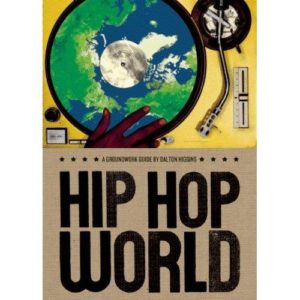Hip-Hop takes on the characteristics of its user and reflects his environment, regardless of location. The American Hip-Hop media tends to lose sight of this, adopting a decidedly xenophobic and myopic view of the culture. Their myopia is often limited to specific region, city, and sound. They rarely veer away from what is popular in the marketplace. More energy should be expended on broadening our perspective and enlightening readers to the full spectrum of the music and the culture it emanates from.
Dalton Higgins’ Hip Hop World looks at Hip-Hop from a global perspective. It considers how Hip-Hop has been appreciated and appropriated by different ethnicities and countries around the world and addresses the rather one sided way the culture is covered in the American media. It chronicles how that coverage affects the way the music is perceived outside of America. Controversial subjects are tackled, and a few sacred cows are tipped over along the way. All of this is attempted in the span of 144 pages.
The opening chapters try to shed light on the lesser known aspects of Hip-Hop’s origins. Thankfully, this examination isn’t limited to established mythology and accepted history. The second chapter focuses on Rap music’s connection to Caribbean culture and its deeper roots in Reggae music. Similarities to Dancehall Reggae are discussed, including a listing of rap pioneers and personalities who are of West Indian parentage and heritage.
Elements such as beat boxing and break dancing are featured. Beat boxers lament the lack of appreciation shown to their art. The book offers reasoning for certain unexplained phenomena, such as how Filipino DJ’s like Q-Bert have become among the most proficient and known turntablists the art form has to offer.
Lots of time is devoted to coverage of Hip-Hop scenes in other countries such as Canada, Cub, and South Africa. Interviews with some of the more prominent artists from these scenes are interspersed throughout the book. We are introduced to such unforgettable personalities as Somali Rapper K’naan and members of the Canadian aboriginal rap group War Party. Both artists use the music and culture as a way to address social issues and bring light to the plight of their people.
The book is rather bold in how it tackles some of the touchier subjects and arguments that have plagued the culture since its inception. Higgins openly challenges the often quoted notion that rap music’s audience is 70% white, citing that no reliable data has ever been produced to support this claim. The mantra that Rap music is created for and by people from the streets is also taken to task. The casual and sometimes violent homophobia that permeates the culture is examined. Higgins doesn’t offer mere academic analysis or a listing of facts. He takes a stand and makes his views known, with little regard conventional wisdom and popular opinion.
Most frustrating about Hip Hop World is its truncated feel. The book tries to cover too many topics in such a small space. Higgins poses some intriguing questions and valid arguments, but the low page count doesn’t allow him to really elaborate on or examine any of these ideas with any real depth. Topics that merit entire chapters are limited to a few pages and in some cases a few paragraphs. Clarence Reid aka Blowfly and the late Rudy Ray Moore merely get a paragraph each. Both have openly laid claim to being pioneers of Rap music, and for Higgins to mention them without offering even a cursory analysis of such claims seems odd.
Hip Hop World might be a handy pocket guide for casual fans and newcomers, but for more knowledgeable fans it simply isn’t enough. It provides a decent starting point for discussion, but doesn’t dig deep enough. Higgins passion and breadth of knowledge on the culture is to be applauded. He knows Hip Hop, and he obviously cares about it. Unfortunately, his reach exceeds his grasp. Hip Hop culture is decades old and deserves the same sort of serious consideration as any other culture based in artistic expression. It begs for a more exhaustive and extensive tome than Hip Hop World.
Out of 5
Follow Malice Intended on Twitter @ http://twitter.com/renaissance1977
Follow Us on Twitter @ http://twitter.com/planetill
Join Us on the Planet Ill Facebook Group for more discussion
Check out Planet Ill’s page on Essence.com
Follow us on Networked Blogs



6 thoughts on “Book Review:Hip Hop World”